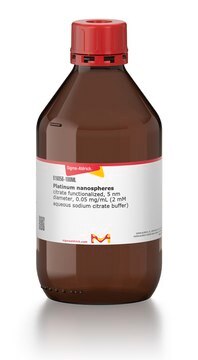685453
Platinum
nanopowder, <50 nm particle size (TEM)
Synonym(s):
Platinum black, Platinum element
About This Item
Recommended Products
form
nanopowder
Quality Level
reaction suitability
reagent type: catalyst
core: platinum
resistivity
10.6 μΩ-cm, 20°C
particle size
<50 nm (TEM)
bp
3827 °C (lit.)
mp
1772 °C (lit.)
density
21.45 g/cm3 (lit.)
SMILES string
[Pt]
InChI
1S/Pt
InChI key
BASFCYQUMIYNBI-UHFFFAOYSA-N
Related Categories
Application
- Main Group SnN(4)O Single Sites with Optimized Charge Distribution for Boosting the Oxygen Reduction Reaction.: This research focuses on the application of SnN(4)O single sites, enhanced by platinum, to improve the oxygen reduction reaction, a crucial process in fuel cells and metal-air batteries. The study highlights the potential of these materials in creating more efficient and durable energy storage solutions. (Shao et al., 2024).
- Hydrogen spillover inspired bifunctional Platinum/Rhodium Oxide-Nitrogen-Doped carbon composite for enhanced hydrogen evolution and oxidation reactions in base.: This paper discusses a composite material using platinum and rhodium oxide, designed to enhance hydrogen evolution and oxidation reactions. This advancement is significant for renewable energy storage and hydrogen fuel cell technologies. (Kumar Manna et al., 2024).
- Rapid synthesis of high-purity molybdenum carbide with controlled crystal phases.: Although primarily focused on molybdenum carbide, this study provides insights into high-purity synthesis techniques that could be applicable to platinum-based materials, potentially benefiting academic research and industrial applications. (Fang et al., 2024).
- Solar-assisted selective separation and recovery of precious group metals from deactivated air purification catalysts.: This research explores a method for recovering platinum group metals from used catalysts using solar energy. This method could be beneficial for sustainable industrial practices and the recycling of high-value materials. (Wu et al., 2024).
Legal Information
signalword
Danger
hcodes
Hazard Classifications
Flam. Sol. 1
Storage Class
4.1B - Flammable solid hazardous materials
wgk_germany
WGK 3
flash_point_f
Not applicable
flash_point_c
Not applicable
ppe
Eyeshields, Gloves, type P3 (EN 143) respirator cartridges
Certificates of Analysis (COA)
Search for Certificates of Analysis (COA) by entering the products Lot/Batch Number. Lot and Batch Numbers can be found on a product’s label following the words ‘Lot’ or ‘Batch’.
Already Own This Product?
Find documentation for the products that you have recently purchased in the Document Library.
Customers Also Viewed
Articles
Professor Ebrahimi and Professor Robinson (Pennsylvania State University, USA) summarize recent advances in the synthesis of these 2D materials, resulting material properties, and related applications in biosensing of neurotransmitters, metabolites, proteins, nucleic acids, bacterial cells, and heavy metals.
Since the demonstration of the first practical solar cell 60 years ago, research on novel materials, improved solar cell design and structure, and innovative manufacturing processes have all contributed to a continuous increase in the efficiency of photovoltaic (PV) devices.
Graphene is a unique two-dimensional (2D) structure of monolayer carbon atoms packed into a dense honeycomb crystal that has attracted great interest due to its diverse and fascinating properties.
Electronically, it behaves as a wide band gap (3.2 eV) semiconductor and exhibits memristor properties.2 Optically, TiO2 has high opacity with a very high refractive index3 (>2.4), and it exhibits strong absorbance in the UV range.
Our team of scientists has experience in all areas of research including Life Science, Material Science, Chemical Synthesis, Chromatography, Analytical and many others.
Contact Technical Service






![Poly[2-methoxy-5-(2-ethylhexyloxy)-1,4-phenylenevinylene] average Mn 40,000-70,000](/deepweb/assets/sigmaaldrich/product/structures/344/488/b8f8179d-3970-4deb-a754-adda88cdb36f/640/b8f8179d-3970-4deb-a754-adda88cdb36f.png)
